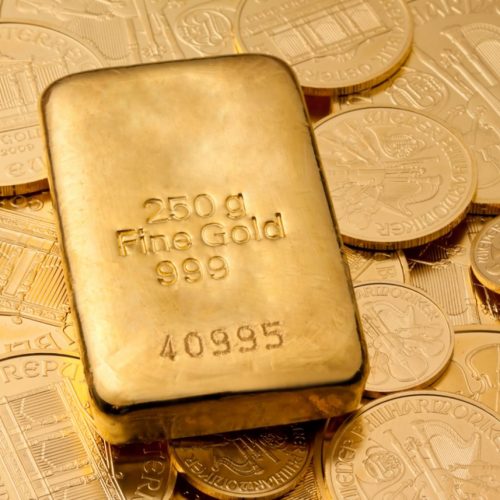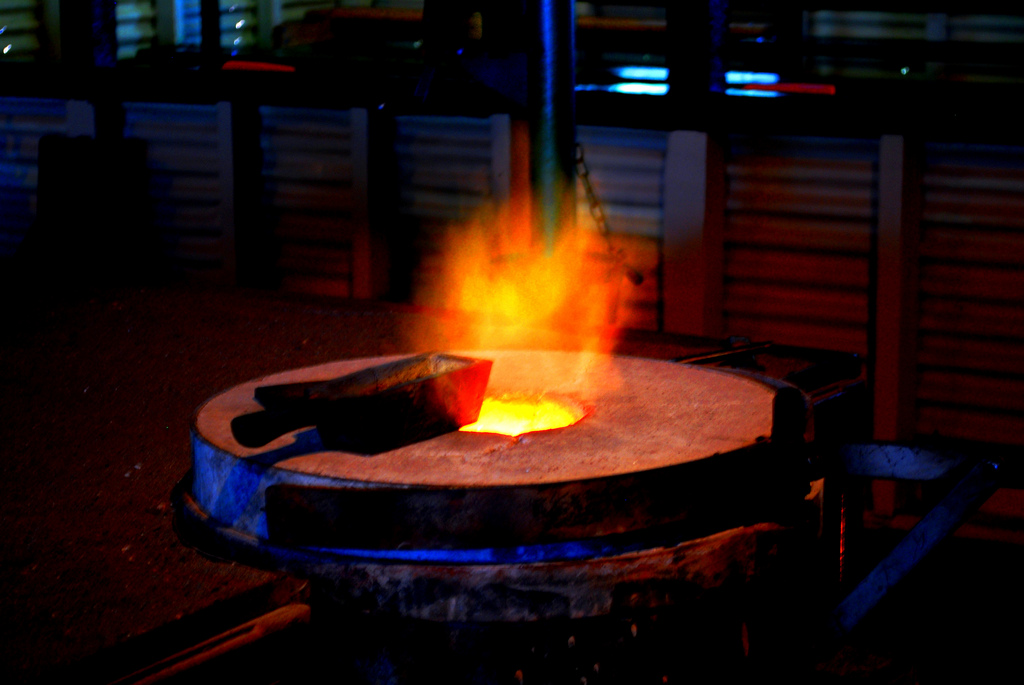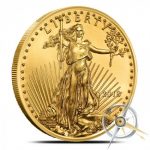
In response to many of our unique gold offerings, we’re often asked exactly how gold is purified. Although most bullion dealers and investors are familiar with the concept of refining, the process itself might be somewhat obscure. In this blog post, we’ll explain the fascinating methods by which gold is purified—and why fineness is important for bullion buyers.
When gold is extracted from the earth, it is often attached to a variety of other minerals. A gold nugget, for example, is likely to have a purity of just 70 to 90%. In many cases, gold occurs in low-purity ore in the form of flecks or fine grains. Vast quantities of soil or sediment must be processed to find tiny quantities of gold. For situations like this, the first step in the refining process is physically separating the gold particles from the surrounding earth. Gold panning is a simple and rudimentary form of this process.
Physical sifting and separation, at best, are just initial steps. To attain a high level of purity, there are only two options: using heat or chemicals. Melting ore results in the actual fine gold settling to the bottom of the liquid mix while the impurities rise to the surface. Using this method, the impurities can be skimmed off the top (thus leaving just the pure gold). This technique, while very quick and efficient, results in a purity of 99.5% at best.
For higher and more exacting levels of purity, most refineries use an advanced and extremely effective chemical method. In essence, the gold ore is lowered into a chemical bath and then an electrical current is sent through the system. While the actual physics and chemistry involved are quite complex, the end result is simple: it produces gold with an astounding purity of 99.99% or higher. This method is a relatively recent invention; it was devised by Emil Wohlwill in 1874. By comparison, the heat method has existed in some form since ancient times.
 Nowadays, the heat and chemical processes are often used in conjunction with each other. The former is used to refine raw ore or low-purity scrap, while the latter is performed to bring the gold up to investment grade or demanding technical standards. It’s not uncommon for gold to go through the heat process as an initial step, then undergo the chemical process if a higher level of purity is desired. Low-purity alloys like 14 Karat (i.e. 58.3% purity) might be suitable for jewelry, but certain applications (like exchange-traded gold or use in electronics) require a purity of 99.99%.
Nowadays, the heat and chemical processes are often used in conjunction with each other. The former is used to refine raw ore or low-purity scrap, while the latter is performed to bring the gold up to investment grade or demanding technical standards. It’s not uncommon for gold to go through the heat process as an initial step, then undergo the chemical process if a higher level of purity is desired. Low-purity alloys like 14 Karat (i.e. 58.3% purity) might be suitable for jewelry, but certain applications (like exchange-traded gold or use in electronics) require a purity of 99.99%.
While many bullion products are 99.99% pure (i.e. 24 Karat), some intentionally are not. Most vintage circulating gold coins were intentionally alloyed with some amount of silver and/or copper for added durability. Examples include pre-1933 US gold coins, British Sovereigns, French 20 Francs, Mexican Gold Pesos, etc. Even modern bullion coins like the American Gold Eagle and South African Krugerrand intentionally contain copper to make them harder and less susceptible to damage. The coins still contain a full troy ounce of fine gold, but the coins weigh slightly more than an ounce due to the additional copper content.
While extremely high levels of purity may sound like an advantage, there is one downside to 99.99% fineness. Pure gold is actually quite soft and prone to abrasions. This is not an issue if your coins or bars are protected in appropriate protective holders. However, if these coins were allowed to jostle around loose in a tube, they might easily pick up nicks and scratches. This is also why most jewelry is 14K, 18K, or 22K. Not only are these alloys less expensive, but they’re also much sturdier.
 A common question is whether 90% or 91.7% pure gold coins are “inferior” to their 99.9% brethren. The basic answer is no. The American Gold Eagle, for example, is probably the world’s best-selling gold bullion coin but is just 91.7% pure. The most important consideration is whether your coin or bar was made by a respected manufacturer. This is one reason why Provident only carries products made by world-renowned mints and refineries.
A common question is whether 90% or 91.7% pure gold coins are “inferior” to their 99.9% brethren. The basic answer is no. The American Gold Eagle, for example, is probably the world’s best-selling gold bullion coin but is just 91.7% pure. The most important consideration is whether your coin or bar was made by a respected manufacturer. This is one reason why Provident only carries products made by world-renowned mints and refineries.
We’d love to hear your thoughts on gold purity. Do you prefer 24K vs 22K? How much does purity affect your collecting and investment decisions? Share your opinions in the comment section below. We look forward to hearing from you!




It would be great if there was a video on the process of gold purification made by the mint producing the gold. Peace , Love & Happiness
Leon Tucker / KY
We’d love that too, Leon! Unfortunately, many mints have proprietary processes that they keep secret.
I stack 22k gold eagles because they are well known and in any situation I would be able to easily sell off. I do have pure 24k gold coins too but only because I liked the coin and wanted to have it, not because of the gold content. Thanks Provident and I would love to see something on the actual refining process in the future!
Thanks Provident Metals,
Nice information
For some reason I prefer pure 99.99 24k, I like the luster, color and feel. The tone is more attractive to me. I know the value of 22k is the same, it still contains one Troy ounce. I own both Eagles and Maples, Peace
I like my gold like my whiskey… the older the better.
In an apocalyptic situation (SHTF) the less pure pre-1933 US gold coins, British Sovereigns, French 20 Francs, Mexican Gold Pesos, American Gold Eagle and South African Krugerrand might be better to hold. They are more durable compared to the high-purity coins. They are generally recognized and their gold content is well known. Thus they would be easier to trade for essentials. The high purity coins would likely not be perceived to be more valuable than their legal-tender grade cousins.
To paraphrase the folks in the crypto-sphere: Regardless of the purity, HODL that gold!
I prefer pure gold 99.9% or pure silver 99.9%.
I really like the American Gold Eagle design but because it’s an alloy I don’t buy it.
The name of the article is “How is Gold Purified”. Yet what we get in the body of the article: “While the actual physics and chemistry involved are quite complex, the end result is simple: it produces gold with an astounding purity of 99.99% or higher.” Not a very good explanation of how it is done. I guess I’ll go ask my Brother who is a chemical engineer.
Sorry this didn’t meet your expectations, Rob. It was a basic overview for the sake of brevity. But it’s good to know there’s an interest in content that digs deeper!
So post another blog with the details.
Go to YouTuber CodysLab and look for his refining gold content. He’s a professor at Westminster College but does a lot of Science in the Garage type content which really helps understand these things for the layman.
24K is what I look for. Because of it I wont buy U.S. coins as very few are pure. If I dont sell them to Provident, it may make a difference to the buyer if it is not as pure. Gold bars and I will get some gold jewlery in Asia that is 23.97 Pure. it because more versitile and gold is beautiful to see and hold.
It’s great that you’ve done your research and know your preferences!
Makes no difference as long as the buyer and seller are both aware of the purity.
I really like everything that have gold in it!! But my preference is 9999 or more for the beautiful color and shine.
You’re in the same boat as many other investors!